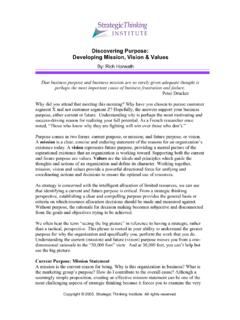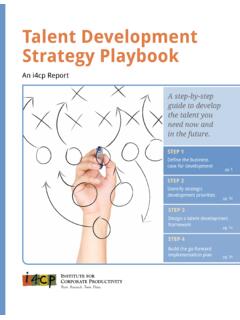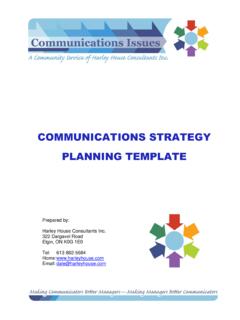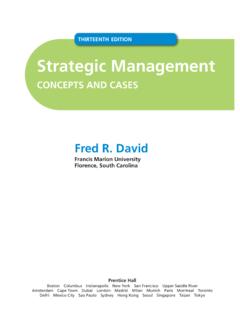Transcription of the THE STRATEGIC MINDSET - Strategic Thinking Institute
1 THESTRATEGICMINDSETAPPLYING STRATEGIC Thinking SKILLS FOR ORGANIZATIONAL SUCCESSthe 2 | THE STRATEGIC MINDSET : APPLYING STRATEGIC Thinking SKILLS FOR ORGANIZATIONAL SUCCESS1 Weisser, C. (2016). The 21 Most Valuable Career Skills. FINDINGSS trategy and its consistent application by managers and leaders are keys to long-term organizational success. strategy is an essential component of STRATEGIC Thinking , a necessary skill for leaders and one that s highly sought after by Being able to think strategically about the big picture and make reasoned decisions that will drive employees in the organization in a common direction means leaders can contribute to business many managers are unclear on exactly what is and isn t strategy , and how to explain it to others or know how to apply it to their daily activities.
2 Recently promoted leaders especially might struggle during the transition to their new role, relying on what s worked in the past and focusing on short-term tactics. This may have proven successful in their previous role, but might not be what the organization needs from them now. Organizations may understand the need for STRATEGIC Thinking , but few have the right tools in place or the necessary skills to leverage STRATEGIC Thinking into an enterprise-wide capability for competitive advantage. To gain a better understanding of the current state of strategy skills at organizations, the Human Capital Media Research and Advisory Group the research arm of Chief Learning Officer partnered with the STRATEGIC Thinking Institute for the CLO strategy Skills survey.
3 We asked survey respondents about the degree to which managers at their organization understand strategy , if they can communicate and apply strategy , and the extent of current measurement of their organization s strategy implementation, application and full demographics information, see CLO strategy Skills survey received 400 responses. STRATEGIC Thinking is the most important leadership capability for senior executives (No. 1 response at percent). strategy skills are taught at just percent of organizations. Only percent of respondents said they teach their managers how to facilitate strategy conversations. Only percent of organizations have a universal definition of strategy , while only 46 percent have a common language for strategy . percent of respondents believe managers at their organizations would benefit from a greater selection of Thinking and planning tools and models to help them develop strategy .
4 3 | THE STRATEGIC MINDSET : APPLYING STRATEGIC Thinking SKILLS FOR ORGANIZATIONAL SUCCESS2 Horwath, R. The STRATEGIC Thinking Manifesto. STRATEGIC Thinking we examine best practices for STRATEGIC Thinking , we should step back and take a big-picture view. Do organizations have a common definition or understanding of what strategy is? Not many survey respondents believe so. Having a definition is essential for giving employees an understanding of how strategy differs from the mission, vision, goals, objectives and tactics. Yet less than half of respondents believe their organizations have either a universal definition ( percent) or a common language (46 percent) for strategy . Where then to begin?What are the characteristics of STRATEGIC thinkers?
5 Among other things, employees who regularly think strategically generate insights on how to create new value, are able to make trade-offs with their resources and effectively prioritize their activities. To create a universal definition, organizations should start with the STRATEGIC Thinking Framework (Figure 1). The framework consists of three A s: acumen, allocation and action. Acumen is where all projects start the idea that will lead to new value either for the customer or the organization. Having acumen requires STRATEGIC insight being able to identify opportunities or solve problems to create and deliver new value. Once the idea has been identified, organizations can move on to the second A: allocation. Budget, resources, people and time should all be considered at this stage.
6 Allocation should reflect STRATEGIC innovation as leaders identify new ways to allocate resources that will deliver value for their customers. After resource allocation is determined, organizations can then act on the program or initiative. By focusing STRATEGIC Thinking through the lens of the framework, organizations free their managers up to focus on the important tasks and not get distracted by fire This last part is key: strategy is not tactics, yet only a third of survey respondents ( percent) are teaching their managers how to recognize the difference between strategy and tactics. STRATEGIC Thinking unleashes the power of managers to solve problems, overcome challenges and creatively take the business from where it is to where it needs to go.
7 Rich Horwath, CEO, STRATEGIC Thinking InstituteSTRATEGY: WHAT IS IT?FIGURE 1: STRATEGIC Thinking FRAMEWORK 4 | THE STRATEGIC MINDSET : APPLYING STRATEGIC Thinking SKILLS FOR ORGANIZATIONAL SUCCESSPUTTING strategy IN THE CORPORATE CLASSROOMFor organizations to be able to realize the benefits of STRATEGIC Thinking , they ll need to include strategy skills in their leadership development programs. There is plenty of room for improvement in this area, as less than a quarter of all organizations ( percent) answer Yes on if their organization teaches strategy skills (Figure 2). Organizations looking to develop a strategy skills program can look to what others are doing for inspiration. Who benefits most from strategy skills training?
8 Organizations mostly teach strategy skills to middle- and upper-level managers. strategy skills are often taught to managers ( percent), directors ( percent) and vice president-level senior leaders ( percent). Common elements in leadership development include how to think strategically, articulate the organizational strategy and apply it to teamwork (Figure 3).How to apply the organizational strategy to department/teamworkHow to articulate the organizational strategyHow to think strategicallyHow to use strategy to prioritize tasksHow to build buy-in for organizational strategy within the department/team65%60%54%53%45%FIGURE 3: ELEMENTS INCLUDED IN strategy EDUCATION42%34%24%n Yesn To some extent n NoFIGURE 2: ARE strategy SKILLS TAUGHT AT YOUR ORGANIZATION?
9 My company does not have STRATEGIC Thinking and planning tools in place. Any tools are learned on the job according to whom and what the director s leadership style is. Survey respondent, CLO strategy Skills survey, open comments 5 | THE STRATEGIC MINDSET : APPLYING STRATEGIC Thinking SKILLS FOR ORGANIZATIONAL SUCCESSPROVIDING THERIGHT TOOLST here s overwhelming support for managers benefitting from a greater selection of Thinking and planning tools and models to help them develop strategy . More than 8 in 10 survey respondents ( percent) agree with this statement (Figure 4).One of the greatest tools for STRATEGIC Thinking is deceptively simple: time. strategy development takes time to focus on new, unproven areas that will bring value to the business.
10 Leaders need uninterrupted time to both develop their necessary skills and concentrate on STRATEGIC tasks. Yet finding time is a challenge for many, with percent of survey respondents saying the lack of time to engage in STRATEGIC skills development is a top challenge to increasing strategy skills. Other challenges include a lack of training on strategy skills and lack of a framework for creating STRATEGIC Thinking habits (Figure 5).FIGURE 4: MANAGERS AT OUR benefit from a greater selection of Thinking /planning tools/models to help them develop strategyUse goals and strategies to drive their daily activitiesEffectively set clear priorities and don t prioritize everything as importantCan clearly differentiate between strategy and mission vision, goals, objectives and tactics83%56%49%41%FIGURE 5.













